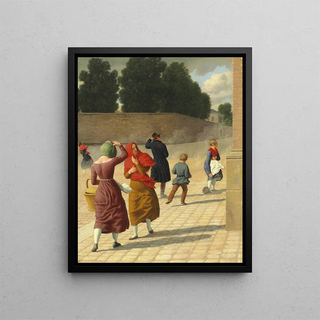Art print | A Storm - Christoffer Wilhelm Eckersberg


View from behind

Frame (optional)
Art print Une tempête - Christoffer Wilhelm Eckersberg – Engaging Introduction
In the fascinating universe of art, some works manage to capture the very essence of nature and human emotion. "Une tempête - Christoffer Wilhelm Eckersberg" is a striking example, revealing not only the power of the elements but also the depth of feelings that can emerge from them. This piece, emblematic of Danish romanticism, transports the viewer to the heart of a tumultuous storm, where the sea and sky clash with palpable intensity. Through this painting, Eckersberg invites us to contemplate the wild beauty of nature while confronting our own vulnerability in the face of its forces.
Style and uniqueness of the work
Christoffer Wilhelm Eckersberg's style is distinguished by his ability to blend detailed precision with a dramatic atmosphere. In "Une tempête," shades of blue and gray blend harmoniously, creating a sense of movement and chaos. The waves, painted with great mastery, seem almost to burst from the canvas, while the swirling clouds add an almost cinematic dimension to the scene. Eckersberg does not merely depict the storm; he explores its psychology, making each brushstroke charged with meaning. This work transcends the simple maritime landscape to become a metaphor for human struggle, a battle between order and disorder, serenity and turbulence.
The artist and his influence
Christoffer Wilhelm Eckersberg, often considered the father of Danish realism, made his mark by adopting an innovative approach to painting. Trained at the Royal Danish Academy of Fine Arts in Copenhagen, he was heavily influenced by European masters, notably the French Impressionists. His ability to capture light and atmosphere paved the way for many Danish artists who followed in his footsteps. "Une tempête" is a perfect illustration of his talent, but also of his desire to depict nature as a living element capable of provoking intense emotions. Through his work, Eckersberg contributed to redefining the maritime landscape, making his paintings reflections on human existence and our place in the world.
A wall decoration of

Matte finish

View from behind

Frame (optional)
Art print Une tempête - Christoffer Wilhelm Eckersberg – Engaging Introduction
In the fascinating universe of art, some works manage to capture the very essence of nature and human emotion. "Une tempête - Christoffer Wilhelm Eckersberg" is a striking example, revealing not only the power of the elements but also the depth of feelings that can emerge from them. This piece, emblematic of Danish romanticism, transports the viewer to the heart of a tumultuous storm, where the sea and sky clash with palpable intensity. Through this painting, Eckersberg invites us to contemplate the wild beauty of nature while confronting our own vulnerability in the face of its forces.
Style and uniqueness of the work
Christoffer Wilhelm Eckersberg's style is distinguished by his ability to blend detailed precision with a dramatic atmosphere. In "Une tempête," shades of blue and gray blend harmoniously, creating a sense of movement and chaos. The waves, painted with great mastery, seem almost to burst from the canvas, while the swirling clouds add an almost cinematic dimension to the scene. Eckersberg does not merely depict the storm; he explores its psychology, making each brushstroke charged with meaning. This work transcends the simple maritime landscape to become a metaphor for human struggle, a battle between order and disorder, serenity and turbulence.
The artist and his influence
Christoffer Wilhelm Eckersberg, often considered the father of Danish realism, made his mark by adopting an innovative approach to painting. Trained at the Royal Danish Academy of Fine Arts in Copenhagen, he was heavily influenced by European masters, notably the French Impressionists. His ability to capture light and atmosphere paved the way for many Danish artists who followed in his footsteps. "Une tempête" is a perfect illustration of his talent, but also of his desire to depict nature as a living element capable of provoking intense emotions. Through his work, Eckersberg contributed to redefining the maritime landscape, making his paintings reflections on human existence and our place in the world.
A wall decoration of






